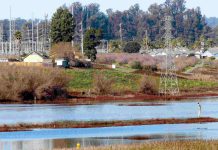
Watsonville city officials on Monday began clearing a sprawling unsanctioned homeless encampment along the Pajaro River that runs from Sakata Lane to Loughead Avenue.
The work, which includes mowing tall grasses and removing some trees, is expected to last through Aug. 2, Watsonville City spokeswoman Michelle Pulido said.
Clearing the camp is in advance of the upcoming $599 million Pajaro River Flood Risk Management Project, which will give 100-year flood protection to the riverside communities of Watsonville and Pajaro.
The work is slated to begin in August along Corralitos and Salsipuedes creeks.
While no major work is planned along the Pajaro River this year, officials still need to make numerous repairs in preparation of the project.
Pulido said that many of the residents dug out sleeping places, compromising the integrity of the levee.
She estimates that roughly 100 people lived there.
“We know that from the start of the year that the homeless encampment has more than quadrupled in size, and there’s some serious concerns, not only about the environmental aspects but also public safety,” she said. “We have real concerns over the levee and its integrity and our ability to protect our residents from potential flood risks.”
Mark Strudley, who heads up Pajaro River Flood Management Agency—the lead agency overseeing the levee rebuild—says the relocation is an essential part of keeping the community safe from flooding.
Many of the people living there, he says, carve out large portions of soil to create living spaces. This weakens the levee by shortening the distance water needs to seep before it creates floods.
Additionally, the soil that makes up a levee must be repeatedly compacted by workers based on engineers’ specifications. So fixing the dug-out portions can be complex and costly, Strudley said.
“Come wintertime, it’s a really big issue for the safety of the community,” he said. “In some ways it’s impossible to make those repairs without doing a cleanup like they’re doing.”
The clearance comes in the wake of a June 28 ruling by the U.S. Supreme Court—City of Grants Pass v. Johnson—which gives jurisdictions the discretion to clear homeless encampments that are deemed unsafe.
Gov. Gavin Newsom on Thursday issued an executive order ordering agencies and governments to address the camps in their jurisdictions, while at the same time helping the residents.
Residents along the levee earlier this week found notices posted giving them 72 hours to vacate.
Manuel Mendoza, 60, says he has been living in the area for about a year, and has been moving from parking lots to shelters to unsanctioned encampments as authorities shuffled him along.
On Wednesday, he was loading a bike trailer with his possessions in preparation for his next move.
He says he and his fellow residents will now move to the other side of the Pajaro River in Monterey County or into the City of Watsonville, where they will sleep in the doorways of businesses.
But he says he has nowhere to go, and authorities have fallen short in finding alternative shelter.
“We’re not cattle,” he says. “Nowadays, even cattle deserve a corral.”
Worse, he says rent is far beyond residents’ financial means, and affordable places to live are scarce.
The solution, he says, is simple: shift funding for non-essential expenses such as park renovations to homeless services.
A self-described outdoorsman, he says that he didn’t like the rigid structure of indoor shelters, such as the recently closed 24-bed Salvation Army shelter.
“I’d rather be outdoors than indoors,” he said. “There’s too much issues.”












Many homeless don’t want to live in a shelter since they can’t booze and take drugs as they like to do. I don’t want my tax dollars to fund drunks and druggies. There are plenty of jobs working in the fields. I guess these druggies would rather loaf, drink and drug using free handouts from city, county and state than work and contribute to society be being a good citizen.